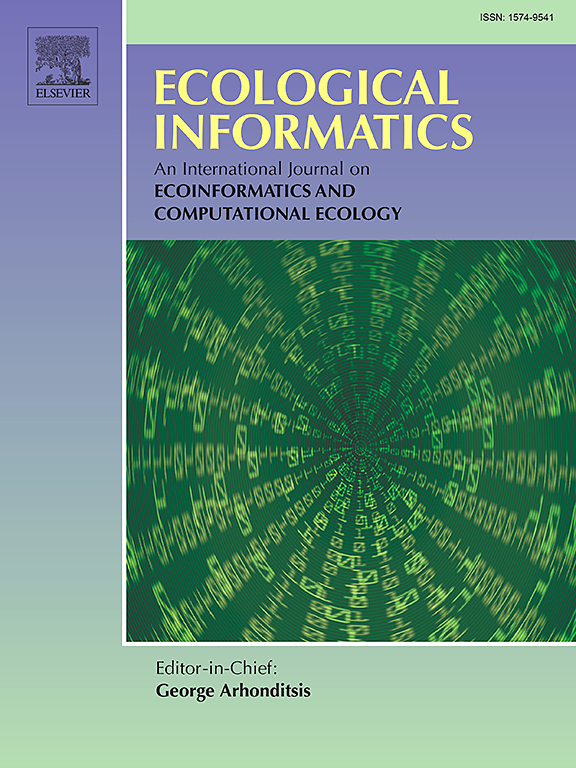A novel method for monitoring Cladophora blooms in Qinghai Lake based on UAV imagery
IF 7.3
2区 环境科学与生态学
Q1 ECOLOGY
引用次数: 0
Abstract
The outbreak of Cladophora in the nearshore region of Qinghai Lake has significantly affected the surrounding ecological landscape and tourism industry. However, existing satellite remote sensing methods for monitoring Cladophora blooms have several limitations owing to cloud cover in optical images and the small areas of Cladophora bloom patches, making it challenging to obtain detailed dynamic characteristics of these blooms. Unmanned aerial vehicles (UAVs) equipped with high-resolution cameras serve as valuable complements to traditional satellite remote sensing techniques. In this study, we propose a new spectral index called the visible band spectral slope index (VSSI) and integrate it with a triangular threshold segmentation algorithm to automatically extract features of Cladophora blooms from very-high-resolution UAV imagery. Comparative analysis with commonly used visible band indices such as the normalized green-red difference index (NGRDI), color index vegetation (CIVE), vegetation (VEG) index, visible-band difference vegetation index (VDVI), and red-green-blue floating algae index (RGB-FAI) demonstrated that the VSSI was most effective for detecting Cladophora blooms. The validation results revealed that the VSSI had the highest accuracy, achieving an F1 score of 0.89 and improving overall accuracy by 11.25 % to 36.92 % compared to other indices' accuracy levels. When compared with UAV images, both Sentinel-2 MSI and Landsat OLI images significantly overestimated the areas of Cladophora blooms by values of 110.65 % and 517.99 %, respectively. Moreover, UAV images captured at different times within the same day confirmed that wind speed and direction are crucial factors influencing dynamic changes in Cladophora blooms over short periods. This work provides a valuable reference for accurately mapping spatiotemporal dynamics of Cladophora blooms and effectively managing lake water environments.
基于无人机图像的青海湖藻华监测新方法
青海湖近岸地区克拉多佛菌的爆发对周边生态景观和旅游产业造成了重大影响。然而,现有的卫星遥感监测方法由于光学图像的云层覆盖和花斑面积小,难以获得花的详细动态特征,因此存在一定的局限性。配备高分辨率相机的无人机(uav)是传统卫星遥感技术的宝贵补充。本文提出了一种新的光谱指数,即可见光波段光谱斜率指数(VSSI),并将其与三角阈值分割算法相结合,从高分辨率无人机图像中自动提取瓢虫花的特征。与归一化绿红差指数(NGRDI)、颜色指数植被指数(CIVE)、植被指数(VEG)、可见波段植被差指数(VDVI)、红绿蓝浮藻指数(RGB-FAI)等常用可见光波段指数进行对比分析,结果表明,VSSI对Cladophora华的检测效果最好。验证结果表明,VSSI的准确率最高,F1得分为0.89,与其他指标的准确率水平相比,总体准确率提高了11.25% ~ 36.92%。与无人机影像相比,Sentinel-2 MSI影像和Landsat OLI影像对Cladophora华的高估幅度分别为110.65%和517.99%。此外,在同一天内不同时间捕获的无人机图像证实,风速和风向是影响短时间内Cladophora华动态变化的关键因素。该工作为准确绘制水华时空动态图和有效管理湖泊水环境提供了有价值的参考。
本文章由计算机程序翻译,如有差异,请以英文原文为准。
求助全文
约1分钟内获得全文
求助全文
来源期刊

Ecological Informatics
环境科学-生态学
CiteScore
8.30
自引率
11.80%
发文量
346
审稿时长
46 days
期刊介绍:
The journal Ecological Informatics is devoted to the publication of high quality, peer-reviewed articles on all aspects of computational ecology, data science and biogeography. The scope of the journal takes into account the data-intensive nature of ecology, the growing capacity of information technology to access, harness and leverage complex data as well as the critical need for informing sustainable management in view of global environmental and climate change.
The nature of the journal is interdisciplinary at the crossover between ecology and informatics. It focuses on novel concepts and techniques for image- and genome-based monitoring and interpretation, sensor- and multimedia-based data acquisition, internet-based data archiving and sharing, data assimilation, modelling and prediction of ecological data.
 求助内容:
求助内容: 应助结果提醒方式:
应助结果提醒方式:


